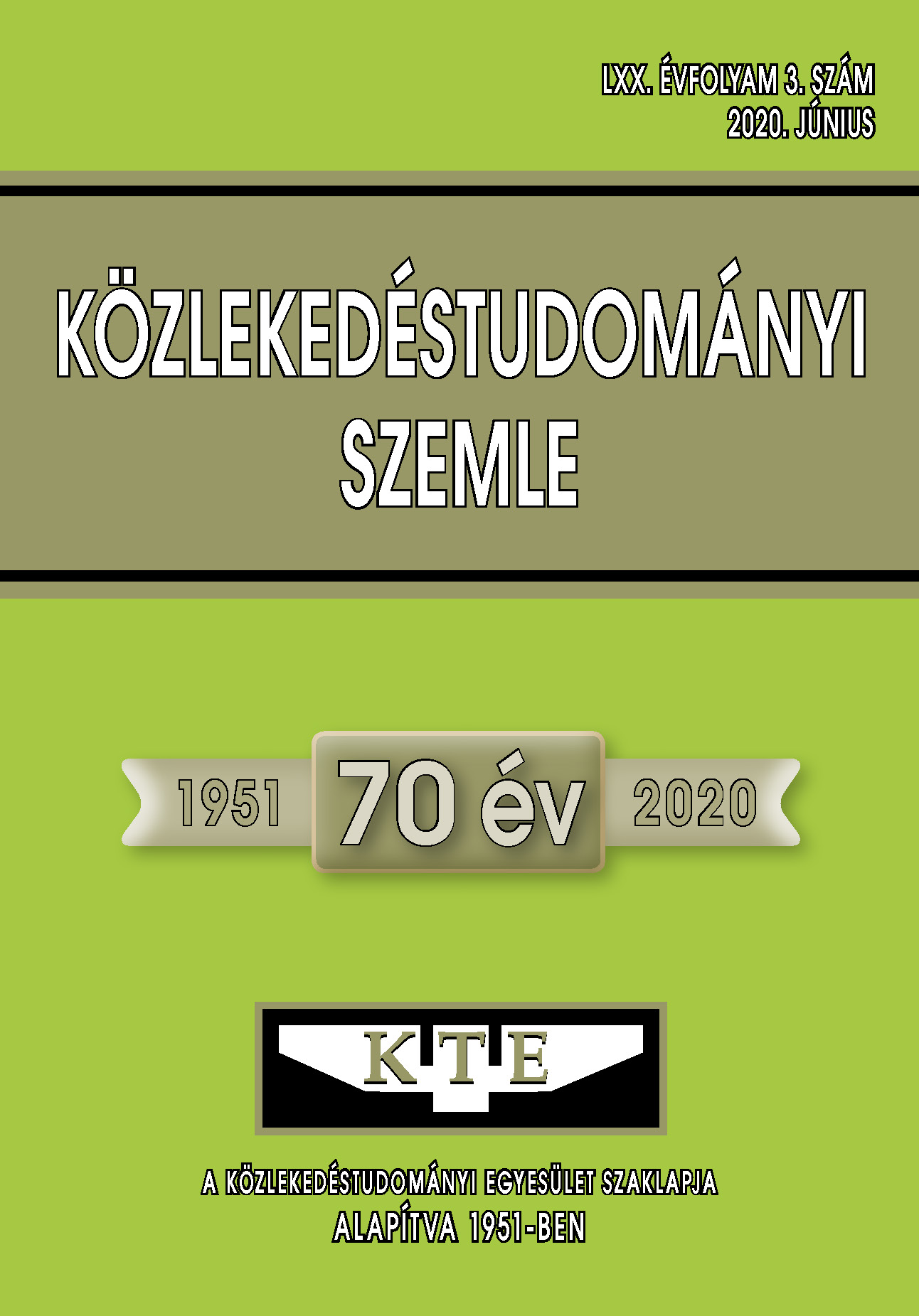Egyensúlyi modellek evolúciója – általános egyensúlyi modellek a közlekedésben
Absztrakt
Kevés magyar nyelvű irodalom létezik a témakörben, ezért fontos az eddigi eredmények összegzése. A számítható általános egyensúlyi modellek egyre népszerűbb módszer a közlekedés gazdasági hatásainak felmérésére, ideértve a közvetlen és a szélesebb körű gazdasági hatásokat is. Segítségükkel meghatározható a gazdaság minden piacának és szereplőjének a viselkedése.
Hivatkozások
Andre de Palma, Robin Lindsey, Emile Quinet, Roger Vickerman (2011) A Handbook of Transport Economics, ISBN 978 1 84720 2031
Arnott, R.J., MacKinnon, J.G. (1977) The effects of the property tax: a general equilibrium simulation. J. Urban Econ. 4, 389–407. DOI: http://doi.org/cbqdsj
Bachmann, C., Kennedy, C., Roorda, M.J. (2014) Applications of randomutility-based multi-region input-output models of transport and the spatial economy. Transp. Rev. 34, 418–440. DOI: http://doi.org/dvgb
Boardman, A.E., Greenberg, D.H., Vining, A.R., Weimer, D.L. (2006) Cost-Benefit Analysis: Concepts and Practice,
rd ed., Pearson international ed. ed. Pearson Prentice Hall, Upper Saddle River, N.J.
Bröcker, J., Korzhenevych, A., Schürmann, C. (2010) Assessing spatial equity and efficiency impacts of transport
infrastructure projects. Transport. Res. Part B: Methodol. 44, 795-811. DOI: http://doi.org/dvv27f
Juhász, M. (2018) Városi közlekedési infrastruktúra beavatkozások hatásainak becslése és értékelő vizsgálata, Doktori tézisek, Széchenyi István Egyetem Multidiszciplináris Műszaki Tudományi Doktori Iskola, Győr
Tánczos, L., Koren, Cs., Timár, A. (2010) A közúti kiadások finanszírozásának jelenlegi magyar és nemzetközi gyakorlata, Közlekedésépítési szemple, 60. évf. 12. sz. /2010, pp. 1-8.
Mackie, P., Graham, D., Laird, J. (2011) The direct and wider impacts of transport procects: a review. In: A. de Palma - R. Lindsay - E. Quinet - R. Vickerman (ed.): A Handbook of Transport Economics; Edward Elgar Publishing – UK/USA, 2011, pp. 501-526)
Martin, P. (1998) Public Policies, Regional Inequalities, and Growth, Journal of Public Economics 73(1):85-105, DOI: http://doi.org/d8rwwv
Nitzsche, E., Tscharaktschiew, S. (2013) Efficiency of speed limits in cities: a spatial computable general equilibrium assessment. Transport. Res. A: Pol. Pract. 56, 23–48. DOI: http://doi.org/f5hm3h
Oosterhaven, J., Knaap, T. (2003) Spatial Economic Impacts of Transport Infrastructure Investments. In:
Pearman, A., Mackie, P., Nellthorp, J. (Eds.), Transport Projects, Programmes and Policies: Evaluation Needs and
Capabilities. Ashgate, Aldershot, pp. 87.
Sullivan, A.M. (1986) A general equilibrium model with agglomerative economies and decentralized employment. J. Urban Econ. 20, 55–74. DOI: http://doi.org/bkrzhc
Sullivan, A. M. (1983) A general equilibrium model with external scale economies in production. J. Urban Econ.
, 235–255. DOI: http://doi.org/cdhqk3
Török Árpád, Bokor Zoltán (2009) Általános egyensúlyi modellek alkalmazása a városi közlekedéstervezésben. In: Péter, Tamás; Nádai, László (szerk.) Innováció és fenntartható felszíni közlekedés 2009: IFFK 2009 Budapest, Magyarország: BME Közlekedésmérnöki Kar, Paper: 2-szekcio/001 , 4 p.
Tscharaktschiew, S., Hirte, G. (2010) The drawbacks and opportunities of carbon charges in metropolitan areas—a spatial general equilibrium approach. Ecol. Econ. 70, 339–357. DOI: http://doi.org/d6p5n4
Tscharaktschiew, S., Hirte, G. (2012) Should subsidies to urban passenger transport be increased? A spatial CGE
analysis for a German metropolitan area. Transport. Res. Part A: Pol. Pract. 46, 285–309. DOI: http://doi.org/dsz3sq
Wangsness, P.B., Rødseth, K.L., Hansen, W. (2016) A review of guidelines for including wider economic impacts in
transport appraisal. Transp. Rev. 37, 94–155. DOI: http://doi.org/dvgd
Wegener, M. (2011) Transport in spatial models of economic development. In: de Palma, A., Lindsey, R., Quinet, E.,
Vickerman, R. (Eds.), A Handbook of Transport Economics. Edward Elgar Publishing.
Az elektronikusan megjelenő cikkek nyílt hozzáféréssel rendelkeznek (OJS), online ingyenesen elérhetők és letölthetők. A cikkek szerzőit nem terheli megjelentetési vagy kiadási költség (APC). Felhasználóknak joguk van a cikkek olvasására, letöltésére, másolására, kinyomtatására, valamint azokban való keresésre, vagy a teljes szöveg linkkel történő megosztására.
A szerzőknek nyilatkozniuk kell arról, hogy beadványukat korábban nem tették közzé más folyóiratban, a pénzügyi támogatás feltüntetésre került és a hivatkozások listája teljes és pontos, beleértve az URL-ek és a DOI-k specifikációját is (ha rendelkezésre állnak). A cikktervezet beadásakor minden szerző jóváhagyja a benyújtott változatot. A szerzők garantálják, hogy a cikk az ő eredeti művük. A szerzők kötelesek részt venni a szakértői értékelés folyamatában, követni a bírálók tanácsait, betartani az előírt határidőket, és amennyiben előfordulnak, kötelesek visszavonni a benyújtást vagy kijavítani a hibákat.
Minden beadott cikket szakértői értékelés alá kerül, ahol a szerkesztők független értékelést kérnek legalább egy szakértőtől, ügyelve arra, hogy a bíráló(k)nak ne legyen összeférhetetlensége a szerzőkkel. A végső döntést a főszerkesztő hozza meg, aki figyelembe veszi az értékeléseket és a szerkesztők javaslatait. A szerkesztők és a lektorok bizalmasan kezelik a beadványt.
A kiadó és a szerkesztők elkötelezettek a magas etikai normák betartása mellett, és megakadályozzák azokat a publikációkat, amelyekben kutatási visszaélés történt. Az ilyen etikai kérdésekben a COPE irányelveit követik.
A szerzők fenntartják a szerzői jogokat, és megadják a folyóiratnak az első közzétételi jogot a Creative Commons Licenc alapján (https://creativecommons.org/licenses/by-nc-nd/4.0), amely lehetővé teszi mások számára, hogy megosszák a művet, elismerve a mű szerzőségét és a folyóiratban való első közzétételt.
A folyóirat archiválja az összes megjelent cikket, és a folyóirat tulajdonosa, a Közlekedéstudományi Egyesület továbbra is üzemelteti az adatbázist abban az esetben is, ha a folyóirat kiadása megszűnik.















